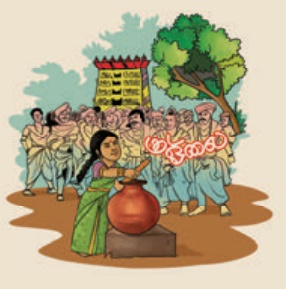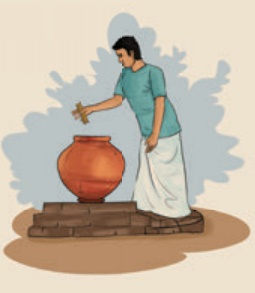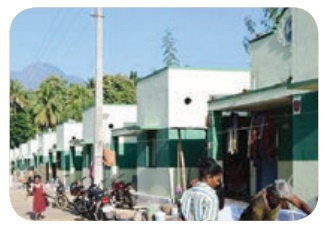Indian Civics - Local Self Governments since Independence | 9th Social Science : Civics: Local Self Government
Chapter: 9th Social Science : Civics: Local Self Government
Local Self Governments since Independence
Local
Self Governments since Independence
The conceptualisation of the system of local self-government in India took place
through the formation and effort of four important committees from the year
1957 to 1986. The Community Development Programme (1952) and National
Extension Service (1953) became a basis for 'The Great Charter on Panchayat
Raj' in 1957.
Salient Features of the 73rd and 74th Constitution Amendment Acts (1992)
·
Panchayats and Minicipalities will be 'institutions of self-government'.

·
Basic Units
of Democratic System
– Grama Sabhas (Villages) and Ward Committees
(Municipalities) comprising all the adult members registered as voters.
·
Three-tier system
of panchayats at village,
intermediate block/taluk/mandal and district
levels. Two-tier for smaller states with population below 2 million.
·
Seats at all levels
filled by direct
elections.
·
Seats reserved
for Scheduled Castes
(SCs) and chairpersons of the Panchayats at all levels also shall be reserved for SCs and STs in proportion
to their population.
·
One-third
of the total number of seats reserved for women. One-third of the seats reserved for SCs and
STs also reserved
for women. One-third offices of chairpersons
at all levels reserved for women.
·
Uniform five year term and
elections to constitute new bodies to be
completed before the expiry
of the term.
In the event of dissolution, elections must
be held compulsorily within
six months.
Salient Features of the Tamil Nadu Panchayati Raj Act, 1994
The New Panchayati Raj System came into being in Tamil Nadu after the enactment of a new law for local body institutions in the year 1994. The salient features of the new Act
are as follows: (a) A three-tier
system (b) Gram Sabha (c)
Establishment of Election Commission (d) Constitution of Finance Commission (e)
Reservation of seats for SC/ST’s proportionate to their population One third
reservation of seats for women and (g) Constitution of District Planning
Committees.
Village Panchayat
Local governments which are function in villages are called
Village Panchayats. The President and ward members are directly elected by the
people. (Those who have attained the age above 18) and their term of office is
five years. District Collector act as the Inspector of Village Panchayat.
Village Panchayats are constituted in each and every village wherever the
population is above 500.
Functions of the Village Panchayat
•
Supply of drinking water
•
Maintenance of street lights
•
Maintenance of roads
•
Maintenance of village libraries
•
Maintenance of small bridges
•
Granting permission to the housing
plots
•
Maintenance of drainage
•
Construction of group houses
•
Cleaning of streets
•
Maintenance of burial grounds
•
Maintenance of common lavatory
facilities
Historical Origin and
Development of Local Self Government in Tamil Nadu
Tamil Nadu has a long
history of local self-governance as is evident from the Uthiramerur stone
inscriptions in Kanchipuram District.

Tamil Nadu, in those
days was a land of village republics, with community groups undertaking many
activities for their area development. This tradition reached its peak during
the 10th and 11th centuries under the reign of Cholas when Village Councils
used to levy taxes, improve community life andadminister justice in their
limited area. These Village Councils had effective links with the Chola rulers.
“Kuda Olai Murai” was the name of the secret ballot method exercised to elect
members to the Village Councils. With the downfall of Cholas, the state
experienced a decline of the village autonomy and rise of the centralized
feudal administrative system. This continued till British rules introduced
local self-governance primarily as an administrative convenien colonial British
Government.

In the post
independence era, the fir t enactment in democratic decentralization in the
state was the Madras Village Panchayats Act, 1950. Pursuant to the White Paper
on the 'Reform of Local Administration' in 1957, the Madras Panchayats Act,
1958 and Madras District Development Council Act were enacted with the
following salient features.

Voluntary Functions.
According to the Tamil Nadu Local Government Act passed
in 1994, the
following functions to be performed
as voluntary functions by the local governments.
•
Maintenance of street lights
in the villages
•
Maintenance of markets and fairs
•
Implantation of trees
•
Maintenance of play grounds
•
Maintenance of parking
vehicles, slaughter houses and cattle sheds
•
Control over places of exhibition
Revenue
Village Panchayat was the only local government which
was empowered to levy taxes
in the three-tier system of Village
Panchayat.
Taxes
•
Property Tax
•
Professional Tax
•
House Tax
•
Taxes for connection of drinking water
•
Land Tax
•
Taxes
levied on shops
Go to the
local government office in your village
and know about the levying of taxes.
Meeting of Gram Sabha
In each and every village,
the people living within
its jurisdiction will be the members
of Panchayat. The
President of the Panchayat will preside over
its meetings. In the
meeting of the Grama Sabha,
the income and expenditure and the beneficiary of the schemes in the village are discussed.

Meetings of the Grama Sabha are conducted four times a year
1. January 26 - Republic Day
2. May 1 - Labourer Day
3. August 15 - Independent Day
4. October 2 - Gandhi Jayanthi
Panchayat Union
Panchayat Union is formed
by grouping of villages. Members
of the Panchayat Union are directly elected
by the people.
The Chairman of the
Panchayat Union is chosen from
among the members.

Functions of the Panchayat Union
•
Supply of drinking water
•
Maintenance of Village Health
Centres
•
Maintenance of roads
•
Establishment of Maternity Homes
•
Establishment of Public fairs
•
Establishment of
Veterinary hospitals
•
Maintenance of Social forests
•
Repairing of Primary School
buildings
Where will you report
if street lights
are not functioning and drinking water
is not available in the tap in your village?
The
district collector, Planning officer,
concerned Block Development Officer are empowered to supervise the developmental
functions of the Panchayat Union.
District Panchayat
A District
Panchayat is constituted in each district.
One district Panchayat is constituted for every 50,000
people and the ward members
are directly elected
by the people. The Chairman is elected from one among its members
and their term is 5 years.
Functions of District Panchayat
•
Advising
the government about the developmental
schemes of the Village Panchayat and Panchayat Union.
•
Supervising
the functions of District Planning Commission.
Urban Local Government
• Town Panchayat
• Municipality
• Corporation
Gandhi’s Concept of Gram Swaraj
Gandhi really wanted ‘Swaraj’, the self rule by the people of India who represent the rural mass. He observed 'India’s soul lives in the village'. He dreamt of village republics in terms of Panchayat in free India.

Mahatma Gandhi
advocated Panchayat Raj, a decentralized form of government, where each village
is responsible for its own affairs, as the foundation of India’s political
system.
In
simpler words, Gandhi’s ideal village should be basically self-reliant, making
provision for all necessities of life-food clothing, clean water, sanitation,
housing, education, and other requirements, including government and
self-defense
Town Panchayat
The area where
more than 10,000
people live is called a Town Panchayat. Members and President
of the town Panchayat are directly elected by the people. There is an Executive
Officer to look after the administration of the
Town Panchayat and their term of
office is 5 years.
Municipality
The area where more than 1,00,000 people live
is
called a
Municipality. The Members and
the Chairman of the Municipalities are directly elected by the people and their term of office
is five years. A Municipal Commissioner is appointed by the government to administer
the Municipality.
Corporation
Municipal
corporations are established in big cities
where the city
has many lakhs
of population. The Municipal Commissioner
is the Administrative Officer. The Mayor is
the Chairman of the corporation. The term of office
of the Mayor and other members
is five years.
In Tamil Nadu, there
are 12 Corporations.
They are in Chennai, Kovai, Madurai, Trichy, Tirunelveli, Salem, Erode, Vellore,
Tuticorin, Tirupur, Tanjore, Dindigul.
The Municipal
Commissioner will be a person from
the Indian Administrative Service (IAS).
All the decisions of the Corporation Council will be implemented by him. He will be assisted
by the office of the
corporation.
Name the
British Viceroy after
whom the building of Chennai Corporation is name.

Important functions of the Mayor
•
He acts as a bridge between the members
of the corporation and the government
•
He presides over the meetings of the Corporation Council
•
He receives the dignitaries from foreign
countries
Types of other Urban Panchayats
•
Notified Area Committee
•
Town
Area Committee
•
Cantonment Board
•
Township
•
Port Trust
•
Special Purpose Agency
Elections to the local government in Tamil Nadu
The State Election Commission conducts the elections
to the local government like general
elections. The electoral roll is prepared ward wise.
Seats are reserved for
the SC & ST and also for the women
in proportion to the population
by rotation basis.
Problems and Challenges facing
the Local Self Governments
Local
self governments are the crucial basis for our democracy. The Constitutional
status of local self governments adds
more significance to their functioning. There
are, however, a few critical
concerns in the working
of local self governments in India.
Major problems and challenges may be mentioned as below:
• Lack of clear demarcation of powers and
functions of local bodies
• Allocation of funds and needs assessment
are not matched
• Role of caste, class and religion in
decision- making at the local self governments
• Poor accountability of elected members and
officials at the grassroot levels of democracy
Piped water supply scheme in Erode Municipality:-
Periyar
E.V.Ramasamy became the Chairman of Erode Municipality in 1917. During his tenure in
Erode Munici p a li t y, Periyar worked effectively for Providing piped drinking
water supply and health facilities to the people. Piped water supply scheme was
implemented in 1919 by Periyar. This scheme was said to be first of kind in the
history of Indian Municipal administration.

Odanthurai Panchayat
With
permanent concrete houses built over a period, the village now has been
declared as hut less village which provides continuous water supply, quality
road networks to the residents.

The most
notable among Odanthurai's Self-help ventures is its experiments with renewable
energy sources. By awaiting loan from the banks and subsidy by The Government,
the village panchayat had installed a small wind tarn at the cost of Rs.2.3 Cr
which generates around 7.5 lakh units of electricity in a year. While the
Panchayat’s need is only 2.5 lakh units, the remaining power is sold to
TANGEDCO, fetching an annual income of around R.s 20 lakh. Moreover the
panchayat had installed a 9kw biomass gasifier Power generation system to
substitute the grid electricity for pumping drinking water.
Solar
based streetlight and biogas system connected to houses for cooking purpose are
some of the highlights of the self-reliant in energy aspect by this model
village panchayat, Odanthurai
Related Topics